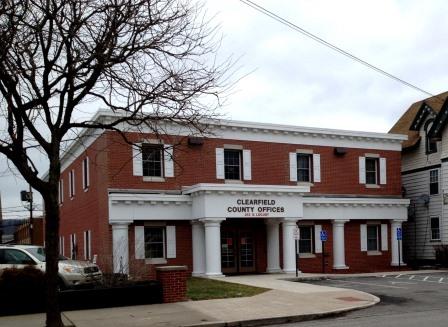CLEARFIELD – Clearfield County is considering an ordinance to combat blight.
At Tuesday’s county commissioners’ meeting, Community Development Specialist Lisa Kovalick presented information on proposed Blight Ordinance 2020 #1 that, if approved, would implement Act 152 of 2016.
She said the county isn’t facing this issue alone because blighted structures can be found across the commonwealth of Pennsylvania and the nation, and are adversely impacting communities.
She said blighted structures: decrease the values of surrounding properties; erode health and local housing markets; pose safety hazards; reduce tax revenue; and cause social and environmental issues.
“Vacant, blighted properties make people feel less safe and less proud of their neighborhoods,” Kovalick said, and so the county’s Planning & Community Development office conducted a housing needs and market study in 2012.
She said that 24 of the county’s 51 municipalities identified 313 blighted properties, and this accounts for 47 percent of the municipalities in Clearfield County.
Kovalick said the listed causes for blight included: absentee property owners and lack of landlord maintenance; lack of property maintenance following a death; lack of maintenance by elderly community members; fire damage or foreclosure; and bankruptcy or costly maintenance.
Following the housing study, she said the commissioners created a Blight Task Force and a blight study was conducted in 2014.
She said it established the following strategies: educating the public on the tax sale process; encouraging municipalities to enact ordinances that require absentee property owners to provide contact information for a local manager of the property; and conducting a county feasibility study on establishing a land bank.
Kovalick said other identified strategies included: a consumer-oriented “how to” maintenance guide to prevent blight; municipal ordinances that would require code inspection prior to the sale of properties; and municipal efforts to effectively deal with blighted properties.
She said some of these strategies have been put in place and proven to be effective, as municipal officials continue to learn more about ordinances that can facilitate blight prevention. And her office has developed a guide of home maintenance tips.
Kovalick said she’s been working with all 50 of the county’s municipalities and linked the two studies as part of a county blight prevention effort. In December, she said the county applied for HOME funds to proactively help conquer its blight issue.
“But our office continues to be inundated with inquires and requests for assistance to help municipal officials and members of the public remove blighted structures,” she said.
“Grant funding is minimal and restricted with state and federal regulations that impede projects from moving forward.”
Kovalick subsequently requested the commissioners to consider the implementation of Act 152 of 2016. She said it’s a law that would help generate funds to assist with the demolition of blighted structures.
She said the funds would come from imposing a nominal fee of $10 on the recording of deeds and mortgages. In turn, she said it would generate $40-$50,000/year to assist municipalities and non-profits with the demolitions.
Because blight causes economic disinvestment, withdrawal of industry and increased unemployment, Kovalick said the ordinance would be a reinvestment in the people and communities of Clearfield County.
The commissioners will now advertise the ordinance, and its implementation will be considered at a future board meeting.
Also, on Tuesday, the commissioners approved Resolution 2020 #2 to urge the reauthorization of collection of fees to the Abandoned Mine Land Reclamation Fund.
According to information presented by representatives of the county’s Conservation District, U.S. Reps. Glenn ‘GT’ Thompson (PA-15) and Matt Cartwright (PA-08) introduced H.R.4248, the Abandoned Mine Land Reauthorization Act, to reauthorize the Abandoned Mine Land (AML) trust fund, originally established in 1977 via the Surface Mining Control and Reclamation Act.
The bill would not only clean up abandoned coal mines, but also foster economic development in communities that have been impacted by their closure.
Of Pennsylvania’s 67 counties, 43 have abandoned mine land sites, with Pennsylvania’s 15th District ranking first nationally. It was noted that Clearfield County – alone – has over 600 abandoned mine land sites.
According to a previously-issued press release from Thompson’s office, the current fund is set to expire in September of 2021. The AML Reauthorization Act would:
- extend states’ authority to collect fees at current levels for 15 years;
- expand funding for states that have not been certified for reclaiming high-priority coal AML areas;
- provide for the delegation of emergency AML programs to states; and
- reimburse states for AML fees that were sequestered since Fiscal Year 2013.
In other business, the commissioners:
- approved a PA SAVIN maintenance and service agreement.
- approved to correctly set the solicitor’s salary at $52,395.
- approved the certification of county funds to Farmland Preservation for the 2020 program year.
- approved the appointment of Susan Williams to the Clearfield County Recreation & Tourism Authority for a four-year term that will expire Dec. 31, 2023.
- approved the appointment of Lynn Dennis to the Community Connections board for a three-year term that will expire Dec. 31, 2022.
- approved the appointment of Shawn Arbaugh to the Clearfield County Solid Waste Authority for a five-year term that will expire Dec. 31, 2024.
- approved the appointment Robert Strouse to the Local Emergency Planning Committee.
- approved the appointment of Susan Williams to the Curwensville Lake Authority to fill an unexpired term through Dec. 31, 2020.
- announced vacancies on the Clearfield County Planning Commission and Community Connections Advisory Board. Persons should express interest in writing to the Clearfield County Commissioners’ office.
- approved one new hire, one employee transfer and two employee separations/retirements.
- approved the bills as presented by the Controller’s office.
- approved the minutes from the Jan. 6 reorganizational meeting as presented by the chief clerk.
